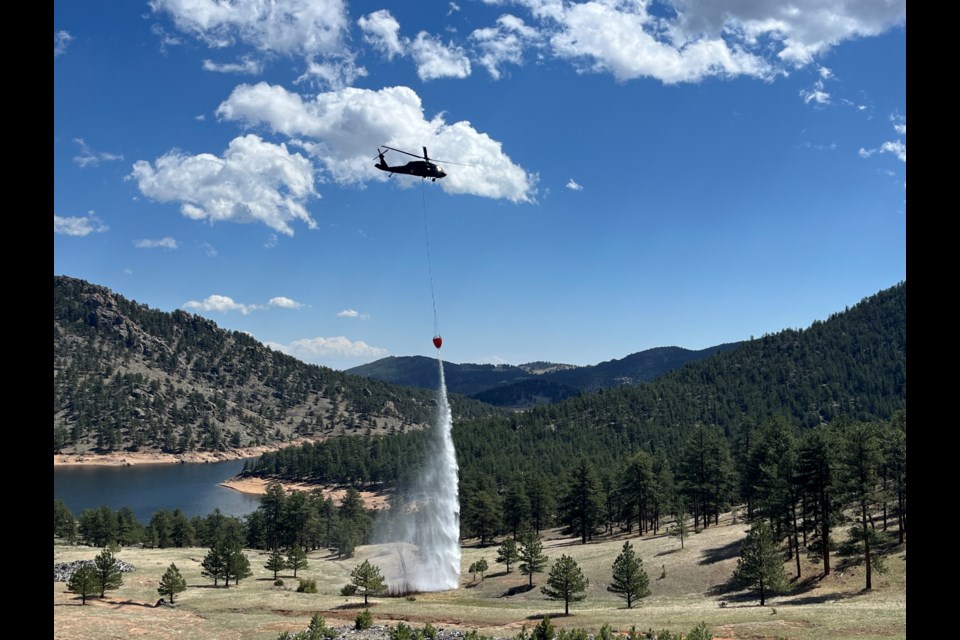On April 16 and 17, the Colorado Division of Fire Prevention and Control (DFPC) and Colorado National Guard (COARNG) conducted helicopter-based fire suppression training and instruction as part of the annual Colorado Fire Aviation Summit (COFAS). The interagency wildland fire training happened at Vance Brand Airport and Button Rock Reservoir in Longmont, where the agencies practiced targeted aerial water delivery.
Erin Doyle, a wildfire operations specialist for the City of Boulder Fire Rescue and the incident commander for the training event, said that the objective of the annual interagency training is to “emphasize a coordinated and risk-informed decision making process that leverages ground and aerial resources to their full potential, while maintaining strict adherence to safety protocols.” The training allows for civilian and military personnel to practice communication and situational awareness when using aircraft to support fire suppression efforts.
“We have been doing this for over a decade and it’s cool to see the evolution,” said Sonya Straka, an aviation specialist with the Colorado Department of Public Safety who served as the helibase manager for the training. She said that the training helps to improve cooperation between civilian and military agencies and teaches crews how to adapt in a training scenario, which increases readiness for an actual wildfire event. “It will lead to more preparedness for the real thing in the end.”
Within a few weeks of a previous training, Straka said that a fire occurred in the same training location where DFPC and COARNG had practiced fire suppression. “We were ready to go,” she said. “We are able to adapt and overcome. We’re soldiers and fire fighters, that’s what we do.”
On April 17, the training largely took part in the Button Rock Preserve area. COANG pilots and personnel used Black Hawk helicopters affixed with Bambi Buckets to practice retrieving water from the Button Rock Reservoir (and other surrounding bodies of water) and distributing it onto targets marked with orange flags and netting. Black Hawks are used primarily by the military for troop and cargo transport, air assault, search and rescue, special operations, humanitarian aid, and natural disaster relief. Bambi Buckets are 600-gallon capacity water buckets made to attach to helicopters for aerial fire fighting.
Personnel were located at different divisions surrounding the simulation “fire” at the preserve, which helped the agencies practice controlling a wildfire from the perimeter.
Representatives from DFPC worked on the ground at the preserve to communicate with COANG regarding potential hazards and gave feedback via radio on the accuracy of water drops. COANG practiced spot drops, in which the entire contents of a Bambi Bucket is dropped on one particular fire spot, and trailing drops, in which the bucket’s water contents is released gradually along a fire line to suppress a wider area. DFPC personnel would communicate with COANG after a water drop regarding whether or not the target was sufficiently hit or if they needed to go back and complete a “tag and drop,” or return to the same line of fire and pick up where the last drop left off.
Zachary Smith, a DFPC representative who served as an instructor for the training and acted as the head of one of the divisions during the training, said that the simulation was a great opportunity for training, ensuring safe operations, and practicing communication between agencies.
“Everything we are doing today is for the worst case scenario,” said Captain Eric Shelton from COANG. “We really hope that we never have a fire, we don’t want to see the state on fire... but if it does happen, we want to make sure we are here ready to go.”



